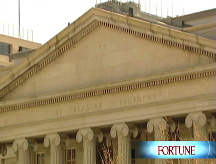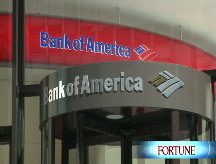Bank bailout: Change is coming
Economy is getting worse and banks' books are still weighed down with junk. Obama will deliver a 'message' for Wall Street to get credit flowing, aide says.
NEW YORK (CNNMoney.com) -- It's back to square one.
The deepening financial crisis, which is undermining the government's rescue efforts, is prompting federal officials to revisit the original bailout measures. These include taking toxic assets off institutions' balance sheets by moving them into a so-called "bad bank," according to published reports.
As long as these assets remain on banks' books, there's no telling how long their losses will continue and how deep they will be.
Addressing these assets was the original purpose of the Troubled Asset Relief Program, the formal name of the $700 billion bailout plan the Bush administration unveiled as the credit crunch spun out of control. It was later abandoned in favor of taking equity stakes in banks, which was seen as a more direct and rapid way to help.
But as the economy worsens and banks continue to rack up multi-billion dollar losses, incoming President Barack Obama, whose aides have already begun consulting with Bush administration officials, will face tough choices in deciding what to do with the $350 billion remaining in the bailout plan.
A top adviser to Obama said Sunday on ABC's "This Week" that the new president will "have a strong message for the bankers."
"We want to see credit flowing again," said David Axelrod. "We don't want them to sit on any money that they get from taxpayers."
The Obama administration, which takes office Tuesday, will discuss how to administer TARP in the days immediately following the inauguration, Axelrod said.
Outgoing Treasury Secretary Henry Paulson said Friday that "a lot of work" has been done on creating a "aggregator bank" and other ideas to leverage the remaining bailout funds to deal with banks' illiquid assets, according to reports. Such a "bad bank" might buy up financial institutions' bad assets, such as mortgage-backed securities, which could stem losses and help rebuild confidence. This is how the federal government first intended to address the credit crisis in mid-September.
Paulson also talked of having the Federal Reserve expand a program to back consumer credit, scheduled to begin next month, and of letting the Fed accept riskier assets, such as commercial mortgage-backed securities. Also, the government could expand its backstop of bank assets as it did for Bank of America, as well as Citigroup.
Meanwhile, Sheila Bair, head of the Federal Deposit Insurance Corp. who will remain in office under Obama, told the Wall Street Journal that federal agencies would like to have "something in place in the not too distant future."
"Everybody agrees it's important to provide some troubled asset relief, because I think it's key to getting private equity capital bank into banks," she told the Journal. "They need to have some certainty about what the tail risk is on some of these assets."
The bank, which would be capitalized with TARP funds, would be similar to the Resolution Trust Corp., which liquidated hundreds of savings and loans in the late 1980s and 1990s, Bair said.
On Tuesday, Fed Vice Chairman Donald Kohn voiced a similar view. And the congressional panel overseeing the TARP wrote last Friday in a report to Congress that events such as November's federal bailout of Citigroup highlight how the toxic asset problem has continued to fester.
Government officials are coming under renewed pressure from financial industry lobbyists, who are pushing them to do more to help banks deal with their bad assets.
"We need to get the markets moving again," said Tim Ryan, head of the Securities Industry and Financial Markets Association. "We have no problem with capital injections, but if you do capital injections without taking care of the bad assets, it just causes the problem to go into hibernation."
The weakening economy is throwing a wrench into the government's efforts to aid the banks. As job losses mount, a growing number of consumers are falling behind on their mortgages, credit cards and other loan payments.
On Friday, Bank of America (BAC, Fortune 500), the nation's largest bank, reported a net loss of $1.79 billion in the fourth quarter of 2008, compared to earnings of $268 million a year earlier. Analysts expected earnings of 8 cents per share.
The loss did not include Merrill Lynch's results. The recently acquired investment bank reported a loss of $15.31 billion, or $9.62 per share. Bank of America cited "severe capital markets dislocations" for Merrill's huge loss, especially late in the quarter.
Citigroup (C, Fortune 500), meanwhile, reported a much bigger-than-expected $8.3 billion quarterly loss Friday, while the beleaguered banking icon also revealed plans to split up into two businesses.
A day earlier, JPMorgan Chase (JPM, Fortune 500) reported net income fell 76% to $702 million, or 7 cents a share during the fourth quarter, from $2.97 billion, or 86 cents a share, during the same period a year ago.
Convincing the American public to support more rescue measures may be tough.
A majority of those polled say the government's financial bailout for troubled banks has not worked so far and six in 10 don't want Washington to spend more money on the rescue, according to a CNN/Opinion Research Corporation survey released Friday.
President-elect Barack Obama will have to decide how to parcel out the remaining $350 billion to all the jockeying interests.
In a nod to congressional Democrats, Obama's officials have already committed to spending up to $100 billion on assisting homeowners facing foreclosure, while Federal Reserve Chairman Ben Bernanke said Tuesday that banks will need more capital injections.
However, Obama said it's crucial to help the banks and get them lending to consumers and small businesses again.
"There's no doubt that we needed to stabilize the banking system," Obama told CNN's John King Friday.
Fortune.com senior writer Colin Barr contributed to this report. ![]()




